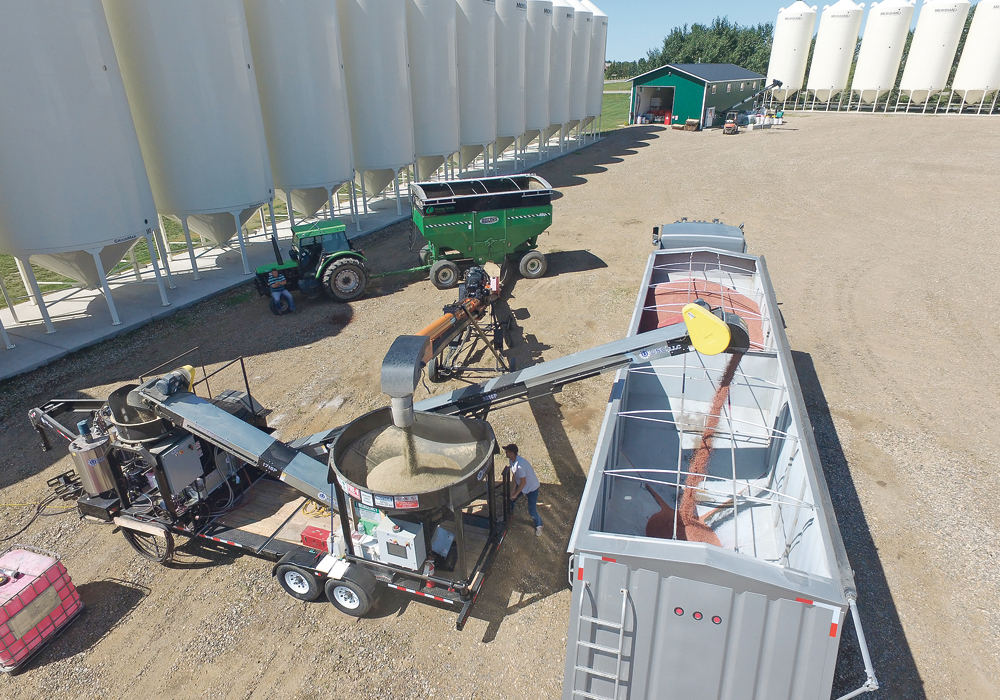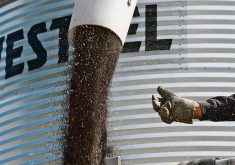The Stamp family takes farm safety seriously.
They hold safety meetings with employees every month to discuss potential hazards and opportunities for improvement and have adopted a number of practices to avoid incidents.
“With our meetings, we bring things up in a formal setting, but it has shown to actually get things done,” said Nathan Stamp, a co-owner of Stamp Seeds, located near Enchant, Alta.
“It allows everyone to think differently, ensuring safety is on their mind when doing their jobs,” he said.
Read Also

Saskatchewan throne speech promises strong economy
Saskatchewan’s legislative agenda for the coming year will focus on meeting the challenges of new world trading relationships, said the speech from the throne.
Stamp Seeds is among many farms that ensure best safety practices, but there are more that could improve.
The family is sharing what they do as part of Farm Safety Week, a time when organizations advocate for safety as farmers get back into their fields for spring.
“I think it’s really good to have Farm Safety Week,” Stamp said. “Any talk about safety is better than hearing about people getting hurt. It helps with awareness. If you don’t talk about it, things don’t happen.”
Latest data from Canadian Agricultural Injury Reporting shows that there were, on average, 85 agriculture-related deaths per year from 2002 to 2012. Hazards from farm machinery caused the most fatalities, according to the figures.
The latest farm safety report card, published in 2011, indicates the industry has lots of work to do to improve safety.
The report, authored by Farm Credit Canada and the Canadian Agricultural Safety Association (CASA), said farmers are good at taking precautions for children, but they continue to work while tired.
“There is still a ways to go,” said Marcel Hacault, the executive director with CASA.
“Farmers take pride in protecting animals, the environment, and by keeping our food safe, but safety is that last pillar,” he said.
There is no silver bullet to improve safety, he said, but awareness campaigns, regulations and training are all helpful.
He said the best way to get more farmers on board is by having other producers lead by example.
“If someone wants to do it, they are more likely to do it than be forced to do it,” he said. “There are so many demands on farmers, so we’re trying to encourage them to make it part of their daily life.”
Wendy Bennett, executive director with AgSafe BC and the former chair of CASA, said even though many manufacturers and farmers are good at promoting safety, more could be done.
“We don’t need farmers to change the way they do stuff, we just need them to think about safety while they are doing it,” she said. “Maybe they’ll take an extra two seconds to make sure the hitch was put on properly instead of second-guessing themselves.”
Despite the challenges, there have been improvements, Hacault added.
He said younger farmers entering the business see safety as integral. They understand safety is important for employees, he said, but also for their family members.
For instance, they don’t let their kids do some tasks but are providing them with alternatives.
“It’s not a matter of saying no,” Hacault said. “It’s about saying that it’s OK to help out, and here is what you can and can’t do.”
Bennett said children are learning about safety at a young age, whether it’s through school or 4-H. Plus, as farmers embrace new technologies, she said, they recognize equipment is different and need to take additional measures.
She said consumers want to know how their food was grown, including the labour that went into it. Employees and producers are out in fields or orchards for hours to ensure the best food is grown.

“I want the consumer to look past the product and at who made it possible for it to be there,” she said.
At Stamp Seeds, Stamp said employees are trained properly and given an orientation before starting the job. They are walked through tasks using a safety manual.
The farm employs 13-14 full-time staff, he said, and may add another seven to eight workers depending on the season. They operate on about 7,000 acres that are mostly under irrigation.
“We’ve become more busy over time, so there are lots more moving parts on the farm and more people,” he said. “We tried to improvise as we went along.”
During a monthly safety meeting, he said, it was pointed out the edges of a scale in the backyard would get slippery. To mitigate that, the farm put grippy tape along the sides to reduce the hazard.
“It’s those little things that go a long way,” Stamp said.
“We want to make sure it’s safe. We’re not just dealing with our family, but other people’s families. We have a duty as an industry to provide a safe workplace. If we wouldn’t want to do a job because of safety concerns, how could we expect someone else to do it?”
Stamp co-owns the operation with his brothers Matthew and Greg. His parents Richard and Marian established the farm and are still involved even though they’ve retired.
Nathan looks after farm operations, while Matthew leads yard operations and Greg oversees seed sales. They grow seed-grade hard red spring wheat, flax, barley, durum, canola, fababeans, peas and quinoa.

















